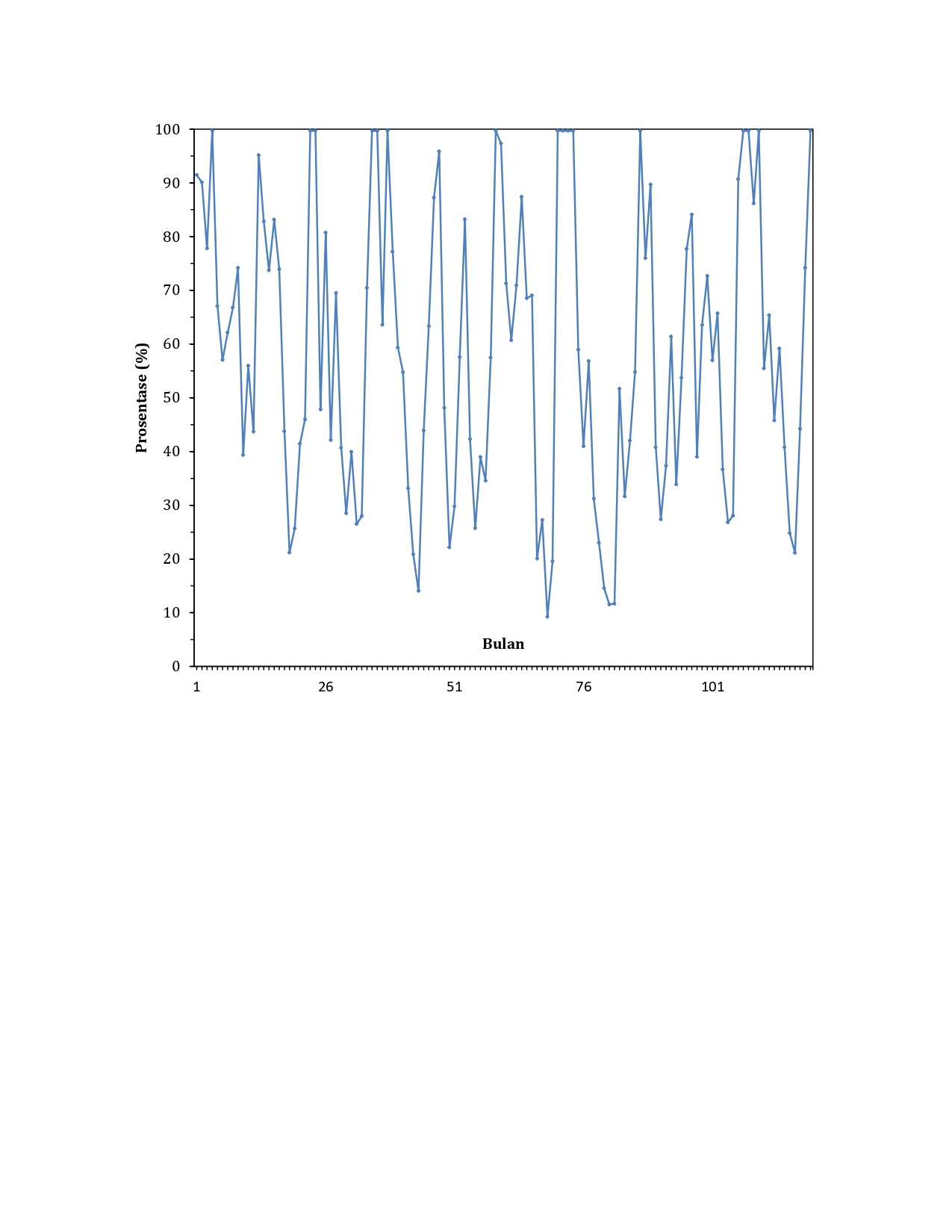Studi Optimasi Operasional Waduk Koto Panjang Untuk Pembangkit Listrik Tenaga Air
Study of Koto Panjang Reservoir Operasional Optimization for Hydroelectric Power Plant
DOI:
https://doi.org/10.25299/saintis.2021.vol21(01).6249Keywords:
Daya Listrik, Debit Andalan, Optimasi, PLTA, WadukAbstract
[ID] Pada musim kemarau PLTA Koto Panjang pernah mengoperasikan satu unit turbin dan generator sehingga daya yang dihasilkan tidak maksimal. Pada musim yang sama PLTA ini juga pernah mengoperasikan tiga unit turbin dan generator namun hanya menghasilkan daya listrik 35 MW dengan prosentase 50 % yaitu 30,702 % dari daya maksimal pengoperasian tiga unit turbin dan generator. Tujuan dari penelitian ini adalah untuk mengetahui debit andalan PLTA Koto Panjang, optimalisasi yang dilakukan dalam mengoptimasi PLTA Koto Panjang, daya listrik yang dihasilkan dari hasil optimalisasi tersebut dan perbandingannya. Metode empiris Penman digunakan untuk menghitung nilai evaporasi. Debit andalan untuk debit outflow PLTA saat ini dan setelah dioptimalisasi dihitung menggunakan rumus daya listrik dan metode mass curve. Selanjutnya debit outflow PLTA yang telah didapatkan dianalisis di dalam tabel water balance menggunakan metode sequent peak analysis. Hasil yang didapatkan adalah debit andalan PLTA saat ini dan setelah dioptimalisasi yaitu 305,319 m3/det dan 384,465 m3/det dengan prosentase 51,995 % dan 39,235 %. Optimalisasi dilakukan dengan menyesuaikan debit outflow dengan volume air yang ada pada storage saat itu. Daya listrik setelah dioptimalisasi adalah sebesar 13.302,315 kWatt pada musim kering dan 143.551,645 kWatt pada musim hujan. Daya listrik yang dihasilkan PLTA saat ini adalah sebesar 13.302,315 kWatt pada musim kering dan 114.000 kWatt pada musim hujan. Sehingga daya listrik yang dihasilkan PLTA setelah dioptimalisasi mengalami kenaikan dari daya listrik sebelum dioptimalisasi sebesar 29.551,645 kWatt. Karena kenaikan daya melebihi kapasitas generator PLTA saat ini, maka terjadi penambahan 1 generator 30.000 kWatt atau 30 MW.
[EN] In the dry season, Koto Panjang Hydroelectric Power Plant has operated one turbine and generator unit so the power produced is not optimal. In the same season, this hydropower plant has also operated three turbines and generators but only produces 35 MW of electricity by percentage 50% which is 30,702 % of the maximum power from operating three turbine and generator units. The purpose of this research is to determine the mainstay discharge of Koto Panjang Hydroelectric Power Plant, optimization will be used for Koto Panjang hydroelectric power plant, power can produce from its optimization and its comparison. The Penman empirical method was used to calculate the evaporation value. The mainstay discharge for hydropower plant outflow discharge at this time and after being optimized is calculated using the electrical power formula and the mass curve method. Furthermore, the hydroelectric power plant outflow discharge has obtained is analyzed in the water balance table using the sequent peak analysis method. The results obtained are the current mainstay discharge of hydroelectric power plant and after optimization, which are 305,319 m3/s and 384,465 m3/s with a percentage of 51,995% and 39,235%. Optimization is done by adjusting the outflow discharge to the volume of water in the storage at that time. The electric power after optimization is 13.302,315 kWatt in the dry season and 143.551,645 kWatt in the rainy season. The current electricity generated by hydroelectric power plant is 13.302,315 kWatt in the dry season and 114.000 kWatt in the rainy season. Therefore the electric power generated by hydroelectric power plant after optimization has increased from the electric power before it is optimized which is 29.551,645 kWatt. Because the increasing of the electric power exceeds the capacity of the current hydroelectric power plant generator, there is an addition 1 generator which is 30.000 kWatt or 30 MW.
Downloads
References
[2] Bishop, Owen, “Dasar-Dasar Elektronika”, Jakarta : Erlangga, 2004.
[3] Keputusan Menteri Permukiman dan Prasarana Wilayah Nomor 360/KPTS/M/2004 tentang Pengoperasian Waduk Tunggal.
[4] Linsley, Ray K dkk, “Teknik Sumber Daya Air”, Jakarta : Erlangga, 1985.
[5] Loucks, Daniel P dkk, “Water Resource Systems Planning And Analysis”, Englewood Cliffs, N.J : Prentice-Hall, 1981.
[6] Mays, Larry W dan Yeou Koung Tung, “Hydrosystems Engineering And Management”, United States of America : McGraw-Hill, Inc, 1992.
[7] Patty, O. F., “Tenaga Air”, Jakarta : Erlangga, 1995.
[8] Peraturan Menteri Pekerjaan Umum Dan Perumahan Rakyat Republik Indonesia Nomor 27/PRT/M/2015 tentang Bendungan.
[9] Soemarto, CD., “Hidrologi Teknik”, Surabaya : Usaha Nasional, 1999.
[10] Soetopo, Widandi, “Operasi Waduk Tunggal”, Malang : CV Asrori, 2010.
[11] Sosrodarsono, Suyono dan Kensaku, Takeda, “Bendungan Tipe Urugan”, Jakarta : PT Pradnya Paramita, 1981.
[12] Sosrodarsono, Suyono dan Kensaku, Takeda, “Hidrologi Untuk Pengairan”, Jakarta : PT Pradnya Paramita, 2006.
[13] Subarkah, Iman, “Hidrologi Untuk Perencanaan Bangunan Air”, Bandung : Idea Dharma, 1980.
[14] Suripin, “Sistem Drainase Perkotaan Yang Berkelanjutan”, Yogyakarta : Andi Offset, 2004.
[15] Tim Penyusun Kamus Pembinaan Dan Pengembangan Bahasa, “Kamus Besar Bahasa Indonesia (Edisi Kedua)”, Jakarta : Balai Pustaka, 1999.

Downloads
Published
Issue
Section
License

This work is licensed under a Creative Commons Attribution-ShareAlike 4.0 International License.
Copyright. This is an open access article which means that all content is freely available without charge to the user or his/her institution. Jurnal Saintis allows the author(s) to hold the copyright without restriction. The copyright in the text of individual articles (including research articles, opinion articles, and abstracts) is the property of their respective authors distributed under the terms of the Creative Commons Attribution-ShareAlike 4.0 International License which permits unrestricted use, distribution, and reproduction in any medium. Users are allowed to read, download, copy, distribute, search, or link to full-text articles in this journal without asking by giving appropriate credit, provide a link to the license, and indicate if changes were made.





